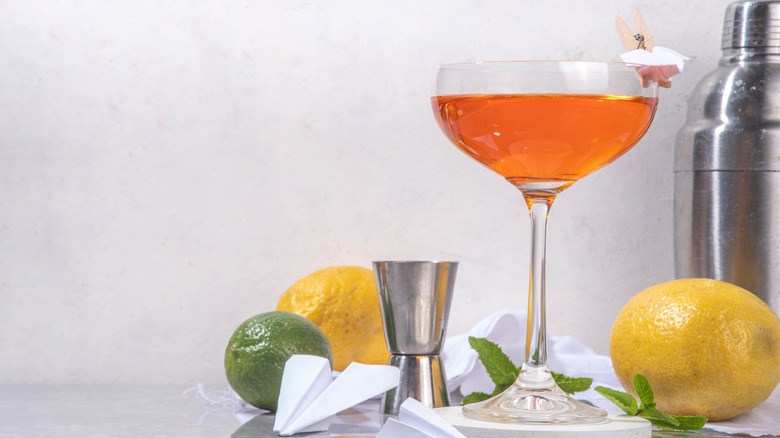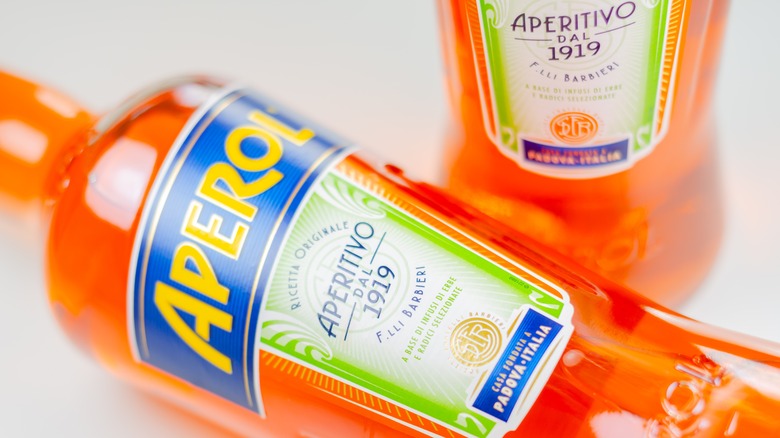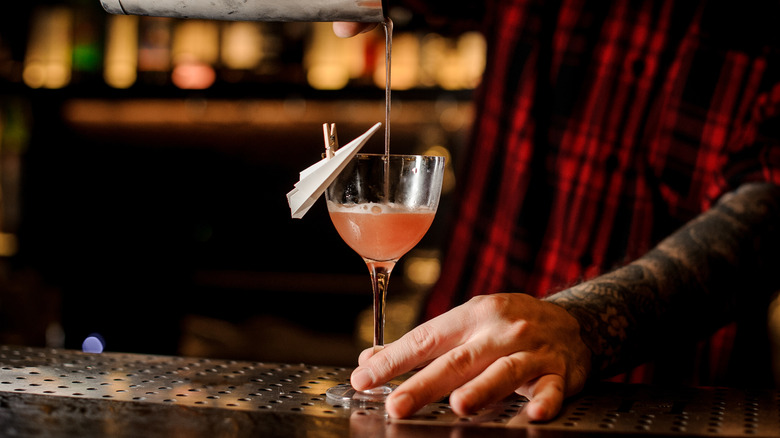If You Love Aperol Spritzes, You Need To Try A Paper Plane
Every sip of an Aperol spritz offers a delightful multi-sensory experience, from the festive pop that comes from opening a bottle of sparkling wine to the burst of vibrant orange color inside the glass. This unique hue is the result of its namesake ingredient, Aperol. While the shade is the result of artificial coloring, it also hints at the fruity taste of the Italian apertif, which is intensely zesty with delicate herbal notes. For those days when you're craving Aperol, but want something a little moodier and more interesting than a spritz, the paper plane is the perfect cocktail.
Like the spritz, the paper plane is characterized by the bright hue and complex flavor of Aperol, with an emphasis on citrusy qualities. The former comes with an orange slice, while the latter is garnished with a lemon zest twist. But while the definitive Aperol spritz recipe calls for two kinds of bubbly liquids — Prosecco and club soda — to create an uplifting effect, the paper plane opts for bourbon whiskey and an Italian amaro instead. As a result, this whimsically-named cocktail is stronger in taste and milder in texture, with more layers of flavor that span from sweet to bitter and a smooth finish.
The story behind the paper plane
While the first glass of Aperol was enjoyed in 1919 in Padua, Italy, it wasn't until 2007 that the paper plane was invented by bartender Sam Ross at The Violet Hour bar in Chicago, Illinois. It was named for the song of the summer — "Paper Planes" by M.I.A. — and inspired by the Last Word cocktail recipe, which is made with gin, green Chartreuse, Luxardo maraschino liqueur, and lime juice.
At a glance, the paper plane and the Last Word don't seem to have much in common; however, each drink is composed of three types of alcohol, plus citrus juice, with each poured in equal measure. The perfect paper plane consists of ¾ ounces of Aperol, Bourbon whiskey, lemon juice, and Amaro Nonino Quintessentia. When preparing this cocktail at home, all the ingredients should be combined in a shaker with ice, then strained into a chilled Coupe glass.
For those unfamiliar with Amaro Nonino Quintessentia, but curious to learn about drinking and (eventually loving) amaro, this brand of bitter Italian liqueur is a good place to start. It uses a base of grappa (liquor made by distilling grapes left over from winemaking) and has been traditionally distilled by a family in northern Italy for over a century. The amaro offers a diverse array of tasting notes from fruity to spicy, caramel-like, and herbaceous.
Variations on the paper plane cocktail
If you're not a fan of bitter drinks, or you're not able to get your hands on a bottle of Amaro Nonino Quintessentia, you're in luck — there are quite a few variations on the paper plane that come with a milder taste and similar aviation-inspired names. For something lighter and sweeter, you may want to try the Airport Bar cocktail instead. To make this riff on the paper plane, all you need to do is swap the amaro for a strawberry liqueur. (In keeping with the fruity theme, you'll also want to garnish the glass with a slice of strawberry, rather than a lemon peel.)
Alternatively, if you're still in the mood for something citrusy, try the Winglet, which forgoes the amaro and adds in a half ounce each of orange juice and grenadine in its place. Or maybe you're not big on whiskey. If so, your ideal orange-colored cocktail may be a different drink that falls somewhere between the paper plane and the Last Word: the Naked and Famous. This provocatively-named beverage also uses an equal portion of each ingredient, but the primary spirit is mezcal, which is mixed with Aperol, yellow Chartreuse, and lime juice.



